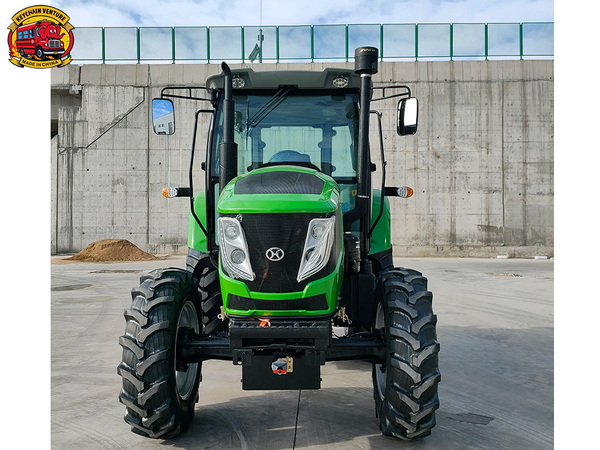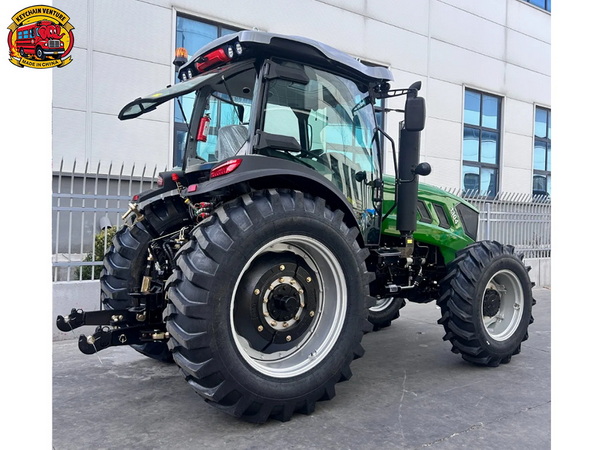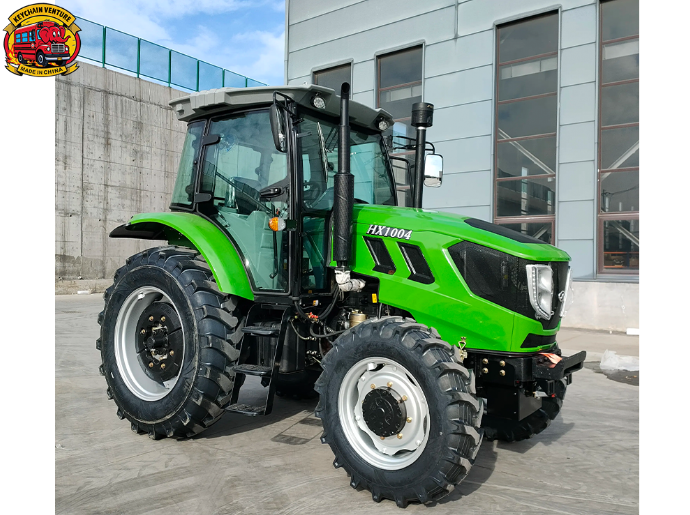Views: 222 Author: Amanda Publish Time: 2025-11-17 Origin: Site








Content Menu
● Tractor Tire Chains: Purpose and Benefits
● Selecting the Best Chains for Your Tractor
● Preparing for Tire Chain Installation
● Step-by-Step Tire Chain Installation Guide
>> Step 1: Lay Out and Prep Chains
>> Step 2: Position Tractor Over Chains
>> Step 3: Drape Chains Over Tire
>> Step 4: Fasten Inside Connector
>> Step 5: Fasten Outside Connector
>> Step 7: Test and Re-Tighten
>> Step 8: Repeat for Remaining Tires
● Tips for Efficient Tractor Tire Chain Installation
● Tractor Tire Chain Maintenance
>> Cleaning
>> Storage
● Common Mistakes and Troubleshooting
>> Troubleshooting Installation Issues
● Enhancing Tractor Performance and Safety
>> 1. Are tire chains necessary for all tractors in winter?
>> 2. Can tire chains be installed on front tires only?
>> 3. How often should tractor tire chains be tightened?
>> 4. Do tire chains damage tractor tires?
>> 5. What is the proper way to store tire chains?
Tractor tire chains are an essential tool for increasing traction and safety when operating on snow, ice, or muddy terrain. Whether clearing a driveway, working on a farm, or navigating challenging landscapes, they transform your tractor into a high-performance machine capable of handling winter conditions and rough ground. This comprehensive walkthrough provides everything needed to select, install, and care for tire chains on your tractor, including detailed instructions, safety recommendations, and insights for maximizing efficiency and durability.

Tire chains for tractors are made from durable metal links, designed to wrap tightly around tires and dig into slippery surfaces where rubber alone might fail. This extra grip prevents wheel spin, helps avoid sliding, and enhances control for both light-duty and heavy-duty tractors, keeping operators safe regardless of weather or terrain conditions. Chains also reduce excessive tire wear during heavy use in harsh conditions, prolonging the lifespan of expensive tractor tires.[5][7][10][11]
Choosing the right tire chains is vital. Consider your typical terrain, the model of your tractor, and the dimensions of your tires.
- V-bar chains: Designed for severe ice and hard-packed snow, offering aggressive grip.[12]
- Diamond pattern chains: Smoother ride on pavement; recommended for tractors that transition between field and road.[13]
- Double ring and studded chains: Best in deep snow and loose, muddy fields—often used in agriculture or logging.[12][13]
- Rubber tensioner chains: Provide a secure fit and reduce vibration for consistent traction.
Always check your tire's width, diameter, and rim specifications before purchasing chains. Consult your tractor manufacturer if unsure about compatibility.[9][11]
- A full set of tractor tire chains, matched to tire size and type
- Work gloves for hand protection
- Jack stand (optional for improved access)
- Rubber or bungee tensioners (recommended for a secure fit)
- Clean cloth for removing debris from tires
- Park tractor on level, solid ground.
- Engage the parking brake and turn off the engine.
- Lay chains out flat behind each tire, with cross links facing down and ends untangled.[1][6][9]
- Inspect chains for broken links or sharp edges; do not use damaged chains.
Place your tire chains directly behind each tire. Arrange them so that hooks or connectors face outward and no links are twisted. This orientation will help the chains grip efficiently and avoid damage to the tire surface.[6][7][5]
Move the tractor slowly backward until the rear tire is centered on the chain. It's critical to keep the tractor stable throughout. Shut off the engine and set the parking brake. This prevents accidental movement during installation.[7][1][6]
Carefully lift and drape chains over the top of the tire, spreading them evenly so the cross links are centered and the main connector system rests on the outside of the tire. This helps with visibility and access during fastening.[2][4][1]
Reach behind the tire, pull the chain snug, and attach the inside connector (quick link, speed hook, or shackle) to a secure link. Ensure slack is minimized without over-tightening at this stage as you'll adjust it further once the outside connector is attached.[5][7]
On the tire's exterior, pull the chain as tight as possible and fasten the outside connector to the corresponding link. Use cams or hooks as designed, ensuring the chain feels snug but not so tight that it might break a link when the tractor is in motion.[9][5]
For added safety and fit, attach rubber or bungee tensioners—a star pattern works best to keep chain tension even across the tire tread. This reduces slack, vibration, and risk that chains will work loose while driving.[7][5]
After both inside and outside connectors are secured, move the tractor forward 50–100 feet. This allows the chain to settle naturally across the tread. Stop the tractor, check for any slack or misalignment, and re-tighten connectors as needed. It's vital to repeat this stage to ensure maximum grip and prevent loose chains from detaching.[6][5][7]
At minimum, chains must be installed on both rear tires, as these drive most tractors. For four-wheel drive, repeat the above steps for the front as well. If chains are only being used on the rear tires, consider adding ballast weight for improved traction in slick conditions.[1][7]

- Use twine or rope: Station baling twine under the chain and tire to help lift and position chains with minimal heavy lifting, especially for large or heavy tires.[3]
- Employ a jack stand: For front tires on smaller tractors, gently lifting the frame may make chain placement easier instead of fighting heavy tires on the ground.[2]
- Check chain orientation: Fasteners and hooks should never face toward the tire, to prevent damage during operation.[4][14]
- Monitor for wear and fit: Inspect chains regularly for bent or broken links.[10]
- Retighten after first use: Chains can shift or loosen as they settle into position while driving—the initial retightening is essential.
After use in snowy or muddy conditions, rinse chains to remove salt, dirt, and plant material. Salt, in particular, can accelerate rust and reduce lifespan.[15][10]
Dry chains thoroughly before storage. Hang them from hooks or store flat in a cool, dry area. Lubricate movable chain parts to prevent corrosion and ensure easy adjustment next season.[10][15]
Check chains for broken, bent, or worn links before each use. Replace any damaged sections for maximum safety and efficiency. Well-maintained chains last for years, even with heavy tractor use.
- Failing to center chains correctly, leading to uneven grip or fender damage.[16]
- Installing chains backwards so hooks or connectors point inwards and may cut tire rubber.[7]
- Selecting the wrong chain size, causing chains to loosen or fall off.[11][17]
- Ignoring tensioners—chains without extra tension may become loose rapidly.[5][7]
- Operating tractor at high speed with chains; slow, controlled driving is safest.[6][10]
- If chains slip or sag after installation, re-tighten and add tensioners.
- For persistent fit issues, confirm your tire size and model matches chain specifications.
- If chains consistently work loose, reduce tractor speed and check for missing links or broken connectors.
- Seek manufacturer recommendations for replacement parts if needed.
Properly installed tire chains convert a standard tractor into a winter-ready, all-terrain machine. Tractors operate more efficiently, with reduced risk of stuck wheels or sliding when towing implements or transporting heavy loads. Optimal chain performance depends on careful installation and proactive maintenance, with operators checking chain position and tightness throughout all operations.[18][10]
Tire chains are particularly valuable for rural property owners, farmers, and commercial groundskeepers, boosting productivity and keeping schedules on track even in winter storms or spring thaws.
Outfitting your tractor with tire chains is straightforward yet essential for reliable operation in winter and on challenging surfaces. Detailed preparation, precise installation, regular checks, and maintenance are the keys to long-lasting, safe, and effective tractor tire chains. Whether you're tackling agricultural work or managing a rural property, following these guidelines will ensure that your tractor remains safe, productive, and equipped to face any adverse conditions.

Tire chains are critical for tractors used on snow, ice, or mud. They prevent wheel spin, help maintain control, and protect both operator and machinery from accidents or excessive tire wear.[10][5]
Chains are most effective on rear tires for two-wheel drive tractors. Four-wheel drive tractors may need chains on all tires for balanced grip and stability, but always refer to manufacturer advice for your model.[1][7]
Chains should be checked and tightened after each use, especially after initial installation. Retighten immediately after the first 50–100 feet of operation to prevent slippage and maintain effective grip.[5][6]
Properly installed chains should not damage tires. However, backward-facing hooks or using broken chains may cause rubber gouging. Regular inspection and correct installation are the best prevention.[14][19][1]
Clean chains thoroughly, dry completely, and store in a dry, cool place away from moisture. Lubricate moving parts if possible and hang chains or lay them flat to prevent tangling or rust.[15][10]
[1](https://www.instructables.com/How-to-Mount-Tire-Chains-to-a-Tractor/)
[2](https://www.youtube.com/watch?v=gFAqp2RqdEA)
[3](https://www.youtube.com/watch?v=AjLe55vaoM8)
[4](https://www.youtube.com/watch?v=RnlI-IKkyVE)
[5](https://tirechain.com/tire-chains-install-instructions/)
[6](https://lacledechain.com/blog/how-to-install-tire-chains/)
[7](https://wallingfords.com/wp-content/uploads/2019/06/aquline-ast-10mm-tractor-tire-chain-installation.pdf)
[8](https://www.tirechainsrus.com/educational/how-to-install-lawn-tractor-tire-chains/)
[9](https://manuals.plus/m/363b589fd85667fb0ecb9e6de79cacdbf530333190e6385f0a4670387a5e9c55)
[10](https://tirechain.com/blog/the-ultimate-guide-to-tractor-tire-chains/)
[11](https://aecoproducts.com/tractor-chains/)
[12](https://www.reddit.com/r/tractors/comments/1ft78lt/tire_chain_recommendationstractors_in_snow/)
[13](https://www.midwesttraction.com/tire-chains/tractor/)
[14](https://www.youtube.com/watch?v=6G3QQMT7YUY)
[15](https://tirechain.com/blog/guide-to-tire-chains/)
[16](https://www.tractorbynet.com/forums/threads/chains-for-snow-ice-what-mistake-is-it-most-important-to-avoid.418033/page-5)
[17](https://www.orangetractortalks.com/forums/threads/putting-on-chains.54820/)
[18](https://tirechain.com/blog/the-importance-of-wheel-spacers-and-tire-chains-for-your-tractor/)
[19](https://forums.yesterdaystractors.com/threads/do-tire-chains-damage-rear-tractor-tires.1419612/)